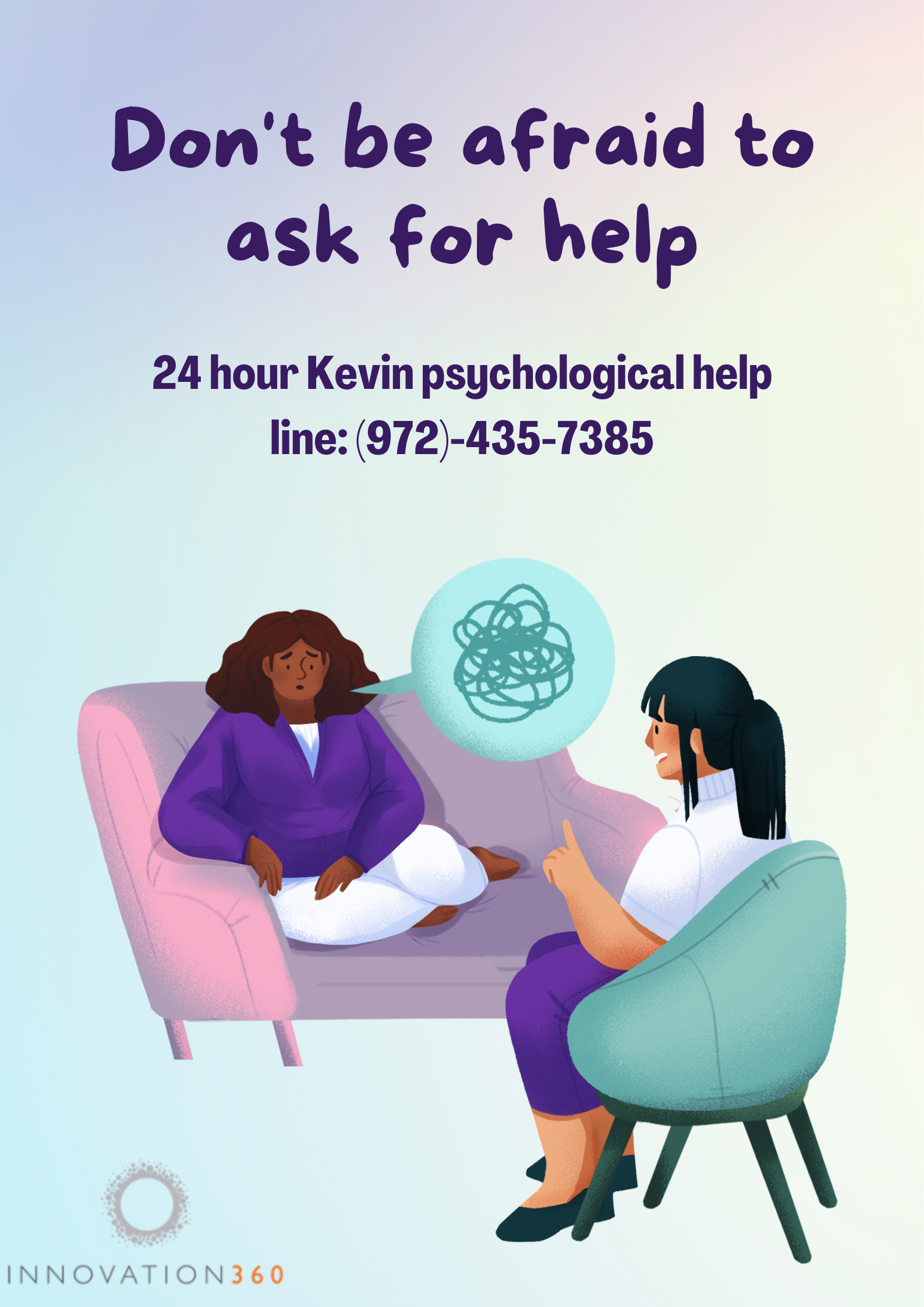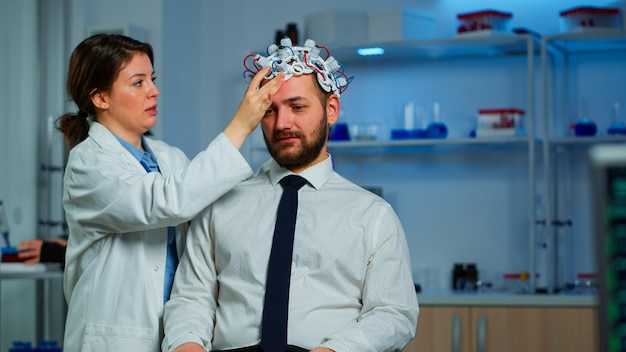Meet Kevin Gilliland | Business Owner, Psychologist & Author
In a recent conversation with Kevin Gilliland, we delved into the motivations behind his decision to start his own business in the field of mental health. Kevin’s insights shed light on the critical need for accessible and tailored mental health services in today’s healthcare landscape. Meet Kevin Gilliland | Business Owner, Psychologist & Author

Innovation360® Dallas is an outpatient group of trusted Counselors, Therapists
Addressing Unmet Needs in Mental Health Care
Kevin’s journey into entrepreneurship stemmed from a desire to address shortcomings in the mental health care system. He saw that traditional options like hospitalization or weekly counseling weren’t always sufficient. Recognizing this gap, Kevin aimed to offer more flexible and personalized services to those in need. Meet Kevin Gilliland | Business Owner, Psychologist & Author
Filling the Void with Innovative Solutions
With a background in healthcare and a deep understanding of the complexities of mental illness, Kevin set out to create a business that would provide comprehensive support to individuals at various stages of their mental health journey. By offering a range of services tailored to meet the diverse needs of clients, Kevin’s business fills a crucial void in the mental health care landscape.
A Holistic Approach to Mental Wellness
One hallmark of Kevin’s business is its holistic approach to mental wellness. Instead of a one-size-fits-all model, Kevin and his team take a personalized approach to each client. They consider their unique circumstances, goals, and preferences. This client-centered approach allows individuals to receive the support and resources they need to thrive.

Kevin Gilliland’s business offers innovative solutions and a holistic approach to mental wellness.”
Bridging the Gap Between Accessibility and Quality Care
Kevin’s business emphasizes both innovative solutions and accessibility. With flexible scheduling, telehealth options, and sliding-scale fees, Kevin ensures services are accessible to all. This commitment to inclusivity and affordability is central to his mission of bridging the gap in mental health care.
Empowering Individuals to Thrive
At the core of Kevin’s business is a commitment to empowering individuals for healthier, more fulfilling lives. Through evidence-based interventions, compassionate support, and ongoing education, Kevin equips clients with tools to overcome challenges. By fostering resilience and self-efficacy, his business makes a meaningful difference in clients’ lives.

Kevin Gilliland’s business bridges accessibility and quality care while empowering individuals to thrive
Conclusion
Kevin Gilliland’s transition from clinician to entrepreneur stems from a desire to address unmet needs in mental health care. By prioritizing innovation, accessibility, and holistic wellness in his business, Kevin is revolutionizing mental health services. His dedication bridges gaps in care and empowers individuals to thrive. When asked about starting his own business, Kevin highlighted the limitations of the traditional mental health system. He observed that options were limited to hospitalization or weekly counseling, leaving many in need of more flexible support. Thus, he aimed to fill this gap by providing tailored assistance to individuals who require more than weekly counseling but less than residential programs.
Why Talking About Drug and Alcohol Addiction is Crucial During the Pandemic
Introduction
The importance of discussing addiction during the pandemic cannot be overstated. With the world facing unprecedented challenges, mental health issues are on the rise, including substance abuse and addiction.

Highlighting the Significance of Addressing Addiction During the Pandemic
Understanding Addiction
Addiction, whether to drugs or alcohol, is a complex condition characterized by compulsive substance use despite harmful consequences. It encompasses various types, including substance dependence and behavioral addictions like gambling or internet addiction.

Impact of the Pandemic on Mental Health and Substance Abuse
Impact of the Pandemic
The pandemic has brought about a myriad of challenges, leading to increased stress, anxiety, and depression among individuals. These factors contribute significantly to the vulnerability of developing or exacerbating substance abuse issues.
Rise in Substance Abuse
Statistics reveal a concerning trend of rising substance abuse during the pandemic. Lockdowns, social isolation, economic uncertainties, and disrupted routines have contributed to higher rates of alcohol consumption, drug experimentation, and relapse among individuals in recovery.
Importance of Awareness
Discussing addiction openly helps break the stigma surrounding it and encourages individuals to seek help without fear of judgment. Raising awareness about the available resources, treatment options, and support networks is essential in promoting healthier coping mechanisms.

Promoting Open Discussions and Support for Addiction Recovery
Seeking Help
It’s crucial for individuals struggling with addiction to know that help is available. Helplines, counseling services, support groups, and rehabilitation centers offer valuable assistance in overcoming addiction and achieving long-term recovery.
Supporting Loved Ones
Friends and family members play a vital role in supporting their loved ones through addiction. Educating oneself about addiction, offering non-judgmental support, and encouraging treatment-seeking behaviors can make a significant difference in someone’s recovery journey.

The Role of Friends and Family in Supporting Addiction Recovery
Recovery and Rehabilitation
Recovery from addiction is possible with the right support and treatment. From detoxification and therapy to medication-assisted treatment and holistic approaches, various options cater to individuals’ unique needs, promoting successful recovery and improved quality of life.
Conclusion
In conclusion, discussing drug and alcohol addiction during the pandemic is crucial for raising awareness, breaking stigma, and promoting support for individuals and their loved ones. By fostering open conversations and providing access to resources, we can collectively work towards a healthier and addiction-free society.
FAQs
- How does stress contribute to addiction? Stress can trigger or exacerbate addiction by influencing brain chemistry and increasing the likelihood of using substances as a coping mechanism.
- What are some signs of substance abuse? Signs may include changes in behavior, mood swings, neglecting responsibilities, physical health deterioration, and withdrawal symptoms.
- How can communities support addiction recovery? Communities can support recovery by offering educational programs, access to treatment facilities, promoting mental health awareness, and reducing social stigma.
- Are online support groups effective? Yes, online support groups provide valuable peer support, education, and resources, making them effective for individuals in recovery or seeking help for addiction.
- What role do family and friends play in recovery? Family and friends can offer emotional support, encouragement, accountability, and assistance in accessing treatment, enhancing the likelihood of successful recovery.
Drug and alcohol-related overdoses have been on the rise since the onset of the pandemic. Addiction specialist Dr. Kevin Gilliland joins LX News to explain why talking about addiction is so important to help understand the root of the problem.
Watch the video here.
The Stigma Around Psychiatric Medication Is Forcing People to Suffer In Silence
Introduction
Psychiatric medication plays a crucial role in managing mental health conditions. However, the stigma surrounding these medications often leads to individuals suffering in silence, hesitant to seek the help they need. Due to what is stigma. This stigma, characterized by negative attitudes, stereotypes, and discrimination towards mental health treatments, creates barriers to accessing appropriate care and support. It can also contribute to feelings of shame, isolation, and reluctance to discuss mental health openly. Overcoming stigma requires education, advocacy, and promoting understanding and acceptance of mental health challenges and treatments. By addressing what is stigma directly, we can create a more supportive and compassionate environment for individuals seeking mental health support.

Breaking the Stigma: Empowering Mental Health Through Proper Medication
Understanding the Stigma
The stigma associated with psychiatric medication has deep roots, stemming from historical misunderstandings and societal biases. This stigma contributes to the negative perception of mental health treatment.
One common misconception is that psychiatric medication is harmful or addictive. In reality, when used correctly and under professional guidance, these medications can significantly improve quality of life without severe side effects.
Effects of Stigma on Treatment Adherence
The fear of being judged or labeled as “mentally ill” prevents many individuals from adhering to their treatment plans. This fear often leads to discontinuation of medication, worsening symptoms, and decreased overall well-being.

Overcoming Stigma: Embracing Mental Health Treatment for Better Well-being
Breaking the Silence on Stigma
Encouraging open conversations about mental health and medication is key to reducing stigma. By sharing personal experiences and fostering understanding, we can create a more supportive environment for those struggling with mental health conditions.
Promoting Mental Health Awareness to Combat Stigma
Education plays a crucial role in dispelling myths and promoting acceptance to combat stigma. Advocating for mental health rights ensures that individuals have access to appropriate treatment without fear of discrimination.
Overcoming Stigma in Communities
Community support groups and initiatives help combat stigma at the grassroots level. Addressing cultural attitudes towards medication is also essential in creating inclusive and empathetic communities.

Building Supportive Communities: Fighting Stigma Through Unity and Understanding”
Conclusion
While the stigma around psychiatric medication persists, progress is being made in raising awareness and promoting acceptance. By working together to challenge misconceptions and provide support, we can create a more compassionate society for all individuals.
FAQs
1 Can psychiatric medication cure mental health disorders?
Psychiatric medication can help manage symptoms but is not a cure for mental health disorders. It is often used in conjunction with therapy and lifestyle changes for optimal results.
2 Are there alternatives to psychiatric medication?
Yes, alternatives such as therapy, lifestyle modifications, and holistic approaches can complement or sometimes replace psychiatric medication depending on individual needs and preferences.
3 What are the common side effects of psychiatric medication?
Common side effects may include drowsiness, nausea, weight changes, or sexual dysfunction. It’s important to discuss any concerns with a healthcare professional.
4 How long does it take for psychiatric medication to work?
The effectiveness of psychiatric medication varies depending on the individual and the type of medication. Some may experience improvements within weeks, while others may take longer.
5 Can you stop taking psychiatric medication once you feel better?
It’s essential to consult with a healthcare provider before stopping psychiatric medication. Abruptly discontinuing medication can lead to withdrawal symptoms and a relapse of symptoms.
6 How can I support a loved one taking psychiatric medication?
Offer non-judgmental support, educate yourself about their condition and medication, encourage open communication, and help them access professional help when needed.
Kevin Gilliland, Psy.D., a clinical psychologist in Dallas, believes some of this shame and misinformation exists because “not all diagnoses are equal.” There’s a hierarchy of sorts when it comes to how we look at different conditions. “People are more than willing to talk about their high blood pressure, but a lot less willing to talk about their STD; similarly, people have become more willing to talk about anxiety or mood issues but less likely to talk about addiction issues. That has to do with perception, bias, fear, experience, and at some level, stigma.”
This stigma not only prevents people from seeking the mental health care and treatment they need in the first place, but also stops them from talking to their doctor about (or even considering) prescription meds, keeps them from filling that prescription, and stops them from taking it continually as prescribed.
There’s more than just anecdotal evidence, either: Surveys (shared by the Centers for Disease Control and Prevention (CDC), American Psychological Association (APA) and published in The Mental Health Clinician — just to cite a few) find the majority of people have witnessed biased and negative views regarding mental health-related issues, or feel that way themselves. At the same time, if we actually treated these issues, our entire world (literally and figuratively) would improve, says Gilliland.
Where did this stigma come from, and why are we still dealing with it in 2020, when diagnoses (and prescriptions) for mental health conditions have increased exponentially? Because stigma, shame, and misinformation at large serve as massive barriers between patients and fundamental healthcare, we need to address this head-on to figure out what we can do about it.
Many Americans Aren’t Quite Sure What an Opioid Is—Here’s What You Should Know
Introduction to Opioids
Opioids are a class of drugs that include both prescription medications and illegal substances like heroin. They are commonly prescribed to manage pain but also have a high potential for addiction and misuse.

Illustration showing various types of opioids, including prescription medications and heroin.
How are opioids different from other painkillers?
Unlike over-the-counter pain relievers such as ibuprofen or acetaminophen, opioids are much stronger and work by binding to opioid receptors in the brain, reducing the perception of pain.
The Opioid Epidemic in the United States
The United States is currently facing an opioid epidemic, with millions of people affected by opioid use disorder and thousands dying from opioid overdoses each year. The widespread availability and over prescription of opioids have contributed to this crisis.
Statistics on opioid use and addiction
According to recent data, over 10 million Americans misuse opioids annually, leading to approximately 70,000 overdose deaths. The epidemic has devastated communities and strained healthcare systems.

Statistics showing the impact of opioid misuse in America: Over 10 million misuse opioids annually, resulting in 70,000 overdose deaths.
Impact on communities and families
The opioid epidemic has far-reaching effects, causing social, economic, and health-related challenges for individuals, families, and communities. The stigma associated with addiction also hinders access to treatment and support.
Types of Opioids
There are several types of opioids, including prescription medications, synthetic opioids, and illicit drugs like heroin.
Prescription opioids
Prescription opioids are medications often prescribed for pain management, such as oxycodone, hydrocodone, and morphine. While they can be effective for short-term pain relief, long-term use can lead to dependence and addiction.
Synthetic opioids
Synthetic opioids, such as fentanyl, are potent drugs that are sometimes illegally manufactured and sold on the black market. They are much stronger than prescription opioids and pose a significant risk of overdose.
Heroin
Heroin is an illegal opioid that is highly addictive and dangerous. It is often injected but can also be snorted or smoked. Heroin use is associated with a range of health complications and societal issues.

Types of opioids: prescription medications, synthetic opioids, and illicit drugs like heroin.
How Opioids Work in the Body
Opioids act on the brain and nervous system, producing pain relief and feelings of euphoria. However, they also disrupt normal brain function and can lead to addiction and tolerance.
Effects of Opioids on the Brain and Nervous System
Opioids bind to opioid receptors in the brain, blocking pain signals and releasing dopamine, a neurotransmitter associated with pleasure. Prolonged opioid use can alter brain chemistry and lead to dependence.
Risk of Opioids addiction and overdose
The addictive nature of opioids makes them particularly dangerous, as individuals may develop a tolerance and require higher doses to achieve the same effects. This increases the risk of overdose, which can be fatal.

Opioids affect the brain and nervous system: pain relief ,euphoria, and potential for addiction.
Signs of Opioid Addiction
Recognizing the signs of opioid addiction is crucial for early intervention and treatment.
Behavioral changes due to Opioids
Individuals addicted to opioids may exhibit changes in behavior, such as increased secrecy, social withdrawal, mood swings, and neglect of responsibilities.
Physical symptoms of Opioids use
Physical signs of opioid addiction include drowsiness, constricted pupils, slowed breathing, constipation, and track marks from injection.
Treatment Options for Opioid Addiction
Treating opioid addiction requires a comprehensive approach that addresses both physical dependence and psychological factors.
Medication-assisted treatment for Opioids addiction
Medication-assisted treatment (MAT) combines medications like methadone or buprenorphine with counseling and behavioral therapies to help individuals reduce opioid cravings and withdrawal symptoms.
Opioids Addiction Counseling and therapy
Behavioral therapies, such as cognitive-behavioral therapy (CBT) and motivational interviewing, are essential components of opioid addiction treatment, addressing underlying issues and promoting long-term recovery.
Opioids Misuse Prevention and Education Efforts
Preventing opioid misuse and addiction involves education, awareness, and proactive measures at the individual, community, and societal levels.
Public health campaigns Against Opioids Misuse
Public health campaigns aim to educate the public about the risks of opioid use, proper medication disposal, and available resources for treatment and support.
Prescription drug monitoring programs for Opioids Control
Monitoring programs track prescription opioid use, identify potential misuse or abuse, and facilitate early intervention and support for individuals at risk.
Conclusion
In conclusion, understanding opioids and their impact is crucial for addressing the ongoing opioid epidemic in the United States. By raising awareness, promoting responsible prescribing practices, expanding access to treatment, and supporting individuals in recovery, we can work towards mitigating the harms of opioids and creating healthier communities.
FAQs
1 What are the common signs of opioid overdose?
Signs of opioid overdose include slowed or irregular breathing, unconsciousness, blue lips or fingertips, and pinpoint pupils.
2 Is it possible to recover from opioid addiction?
Yes, recovery from opioid addiction is possible with the right treatment, support, and commitment to sobriety.
3 Are all opioids illegal?
No, some opioids are prescribed by healthcare professionals for legitimate medical purposes, but they should be used cautiously and as directed.
4 How can I help a loved one struggling with opioid addiction?
Encourage them to seek professional help, provide emotional support, and educate yourself about addiction and available resources.
5 What role do healthcare providers play in addressing the opioid epidemic?
Healthcare providers play a crucial role in responsible prescribing, monitoring patients for signs of addiction, and offering evidence-based treatments for opioid use disorder.
Despite being in the midst of an opioid epidemic that continues to get worse, many Americans, it turns out, aren’t quite sure what the most common opioids actually are, as highlighted in a new survey of 1,000 people.
Conducted by health technology company DrFirst, which includes a network of over 300,000 health-care providers, the survey found that only one in five participants could name five of the seven most commonly prescribed opioids. (For the record, they are: Tramadol, Hydromorphone, Morphine sulfate, Methadone, Hydrocodone, Fentanyl, and Oxycodone.)
The reason why being able to identify opioids is a big deal is because if you don’t know you’re being prescribed one, you won’t be aware of the side effects or risk factors. “[The health repercussions of not knowing if you’re being prescribed an opioid or not] are quite serious as opioids are associated with opioid-induced respiratory depression which can lead to overdose and death,” says family medicine physician and pain management expert Robert Agnello, DO. “Overdose is not difficult. A patient could also take these with alcohol unaware and heighten the risk.”
“It’s important for people to understand the effects that opiates have on the body as well as the impact they can have on judgment and insight,” says Kevin Gilliland, Psy.D, a licensed clinical psychologist and the executive director of Innovation360, an outpatient counseling service that works with people struggling with substance abuse. Here, Dr. Gilliland and Dr. Agnello detail what it’s important to know about opioid medications.
‘A New Way of Life’: Returning to College During COVID-19′
Introduction
Returning to college during the COVID-19 pandemic has brought forth a myriad of challenges and opportunities. This article delves into the complexities faced by students navigating this new normal amidst COVID-19 and explores strategies to adapt effectively.
Challenges of Returning to College During COVID-19
The pandemic has disrupted traditional educational models, leading to uncertainties regarding safety, learning environments, and academic progress. Students encounter challenges such as limited social interactions, technological barriers, and heightened stress levels due to the impact of COVID-19.

The impact of the pandemic on traditional educational models has resulted in various challenges for students.
Importance of Education During COVID-19
Despite these challenges, education remains a vital aspect of personal and professional growth, especially in uncertain times. The pursuit of knowledge equips individuals with valuable skills, resilience, and adaptability necessary to thrive in dynamic environments including those shaped by the impacts of COVID-19.
Adapting to Online Learning Amidst COVID-19 Challenges
One significant shift in education is the widespread adoption of online learning platforms. While this offers flexibility and accessibility, it also presents challenges such as internet connectivity issues, digital fatigue, and the lack of face-to-face interactions exacerbated by the COVID-19 pandemic.

Embracing the Digital Era in Education: Balancing Advantages and Challenges
Pros and Cons of Remote Education During COVID-19
Flexibility and Accessibility in Education During COVID-19
Online learning provides students with the flexibility to study at their own pace and convenience a particularly valuable advantage during the COVID-19 pandemic .It eliminates geographical barriers, allowing access to a diverse range of courses and resources regardless of physical location.
Addressing Technical Challenges and Solutions in Education Amidst COVID-19
However, technical challenges such as unreliable internet connections and learning platform glitches can hinder the learning experience especially during the COVID-19 pandemic. Implementing robust technical support and training programs is crucial to mitigate these issues and ensure a smoother online learning experience for students.
Effective Strategies for Motivation in Learning During COVID-19
Staying motivated while studying remotely requires intentional strategies to create a conducive learning environment.
Creating a Dedicated Study Space
Designating a quiet and organized study space helps minimize distractions and enhances focus which is particularly important during the COVID-19 pandemic when studying remotely. Personalizing the space with motivational quotes, plants, or calming decor can boost productivity and create a conducive learning environment.
Setting Realistic Goals and Deadlines
Breaking down tasks into manageable goals and setting deadlines promotes accountability and prevents procrastination strategies that are especially crucial during the COVID-19 pandemic when adapting to remote learning environments. Celebrating small achievements along the way reinforces motivation and helps students stay engaged and focused on their academic goals.
Joining Virtual Study Groups
Engaging with peers in virtual study groups fosters collaboration, peer support, and a sense of community which are particularly valuable during the COVID-19 pandemic when physical interactions are limited. It encourages active learning and knowledge sharing.
Balancing Responsibilities Amidst COVID-19 Challenges
Many students juggle multiple responsibilities, including work, family, and education. Effective time management and support systems are essential for maintaining balance and reducing stress levels amidst the various demands and uncertainties brought about by COVID-19.
Seeking Support from Employers and Family Members
Open communication with employers about academic commitments and flexible work arrangements can alleviate pressure a crucial aspect during the COVID-19 pandemic when individuals are navigating multiple responsibilities. Family support, including childcare assistance and understanding, contributes to overall well-being.
Coping with Stress During the COVID-19 Pandemic
The transition to online learning, coupled with external stressors, can impact mental health. Implementing self-care practices and accessing counseling services are crucial for managing stress and promoting well-being.
Mindfulness and Self-Care Practices
Incorporating mindfulness techniques, regular exercise, adequate sleep, and healthy eating habits enhances resilience and mental clarity especially important during the COVID-19 pandemic when managing stress and anxiety is paramount. Taking breaks, practicing relaxation exercises, and engaging in hobbies reduce burnout.
Accessing Counseling Services Remotely
Many educational institutions offer virtual counseling services to support students’ emotional and mental health needs. Seeking professional guidance and utilizing online resources can address anxiety, depression, and academic pressures. Seeking professional guidance and utilizing online resources can significantly help students address these challenges and navigate the academic journey more effectively amidst COVID-19.
Future of Education in the COVID-19
The pandemic has accelerated innovations in education, paving the way for hybrid learning models that blend online and offline experiences.
Hybrid Learning Models Post-Pandemic
Combining the benefits of digital learning with in-person interactions and hands-on experiences creates a more holistic educational approach. Adaptive technologies, interactive simulations, and personalized learning pathways enhance student engagement and outcomes providing effective solutions to the challenges posed by COVID-19 disruptions in education.

Achieving Holistic Education: Integrating Digital Tools with Real-world Interaction
Conclusion
Returning to college during COVID-19 necessitates adaptability, resilience, and proactive strategies to navigate challenges effectively. Embracing change, seeking support, and prioritizing well-being are key components of a successful educational journey in the new normal.
FAQs
1 How has online learning impacted student engagement?
Online learning has had both positive and negative impacts on student engagement. On one hand, it has provided flexibility for students to access education from anywhere, leading to increased participation in some cases. Virtual platforms also offer interactive tools and multimedia resources that can enhance engagement. However, challenges such as screen fatigue, limited social interactions, and distractions at home can reduce overall engagement levels. Strategies such as interactive sessions, collaborative projects, and personalized feedback can help improve student engagement in online learning environments.
2 What resources are available for students facing technical difficulties?
Students facing technical difficulties in online learning have access to various resources for support. Educational institutions often provide technical support services, including help desks, troubleshooting guides, and online tutorials. Additionally, many software providers offer user forums, FAQs, and customer support channels. Students can also seek assistance from peers, instructors, or IT professionals within their academic community. It’s essential for students to familiarize themselves with available resources and proactively address any technical challenges they encounter.
3 How can educators create inclusive virtual learning environments?
Educators can create inclusive virtual learning environments by implementing several strategies:
- Providing multiple modes of content delivery, such as videos, text, and interactive simulations, to accommodate diverse learning preferences.
- Ensuring accessibility features are integrated into online platforms, including screen reader compatibility, closed captioning, and adjustable font sizes.
- Promoting active participation through discussions, group activities, and collaborative projects that encourage diverse perspectives and contributions.
4 What role do employers play in supporting employees pursuing education?
Employers play a crucial role in supporting employees pursuing education by:
- Offering tuition reimbursement or financial assistance programs to help offset educational expenses.
- Providing flexible work schedules or remote work options to accommodate academic commitments.
- Encouraging professional development opportunities, such as workshops, seminars, and training programs related to employees’ fields of study.
- Creating a supportive work culture that values continuous learning, growth, and skill development.
5 How are universities preparing for the future of education post-pandemic?
Universities are preparing for the future of education post-pandemic by:
- Investing in digital infrastructure and technology upgrades to enhance online learning experiences and support hybrid learning models.
- Developing flexible curriculum designs that integrate online, offline, and blended learning approaches to accommodate diverse student needs and preferences.
- Implementing innovative teaching methods, such as flipped classrooms, project-based learning, and experiential learning opportunities, to promote active engagement and critical thinking skills.
- Prioritizing student well-being and mental health support services, including counseling resources, wellness programs, and community outreach initiatives.
As the fall semester quickly approaches, college students in the U.S. may feel a mix of emotions while trying to determine how to socialize, handle changing academic formats, and prioritize their mental health. College is already a demanding time for students, and the coronavirus pandemic has been a new and unexpected stressor since the spring.
According to a 2020 study, college students reported increased anxiety and depression during the onset of COVID-19 compared to similar time frames in past academic years.
“This is not an event to tweak, it’s a new way of life to create,” says Kevin Gilliland, Psy.D., executive director of Innovation360, an outpatient counseling service in Dallas, TX. “Be mindful that there is a bug out there and you need to take appropriate precautions—socially distance, wash your hands, and sanitize the surfaces—but you absolutely can have friendships and experiences and learning opportunities that are wonderful.”
COVID-19 Is Changing the Way we Communicate—Here’s How
Introduction
COVID-19 has catalyzed a significant transformation in how we communicate, revolutionizing various aspects of our daily interactions. This article delves into the profound impact of the pandemic on communication patterns, exploring the emergence of virtual tools, shifts in social dynamics, remote work trends, implications for education, mental health considerations, evolving business strategies,

Analyzing the Impact of COVID-19 on Communication Trends
COVID-19Virtual Communication Tools: The Rise of Video Conferencing
One of the most notable changes brought about by COVID-19 is the widespread adoption of virtual communication tools, particularly video conferencing platforms like Zoom, Microsoft Teams, and Google Meet. These platforms have become essential for businesses, educational institutions, and social gatherings, enabling seamless interaction despite physical distancing measures.
Impact of COVID-19 Social Interaction: From Physical to Digital Spaces
With restrictions on physical gatherings, there has been a rapid transition from traditional face-to-face interactions to digital spaces. Social media platforms, messaging apps, and online forums have experienced a surge in usage as people seek alternative means to connect with friends, family, and colleagues.
COVID-19Remote Work Trends: Redefining Work Environments and Communication
The pandemic accelerated the shift towards remote work, transforming traditional office setups into virtual workspaces. This trend has implications for productivity, work-life balance, and the future of office culture, prompting organizations to reevaluate their strategies and infrastructures.

Impact of COVID-19 on Remote Work Transformation
COVID-19Education Sector: Transition to Online Learning
Educational institutions worldwide faced the challenge of adapting to remote learning models. Virtual classrooms, e-learning platforms, and digital resources became indispensable tools for educators and students, highlighting the need for innovative teaching methodologies and technological integration.
Mental Health and Well-being: Addressing Challenges Through Communication
The isolation caused by COVID-19 necessitated a focus on mental health and well-being. Effective communication channels, including teletherapy services, mental health apps, and online support communities, played a crucial role in providing emotional support and resources during challenging times.
COVID-19Changing Business Dynamics: E-commerce and Digital Marketing and Communication
Businesses swiftly pivoted towards e-commerce solutions and digital marketing strategies to remain competitive in a rapidly evolving landscape. The pandemic underscored the importance of digital presence, customer engagement, and agile business models capable of adapting to unpredictable circumstances.

COVID-19’s Influence on E-commerce and Digital Marketing Strategies”
Government and Public Health Communication Strategies
Governments worldwide implemented communication strategies to disseminate accurate information, address public concerns, and promote adherence to safety guidelines. Clear and transparent communication from authorities became paramount in fostering public trust and cooperation.
COVID-19 Social Media Influence: Information Dissemination and Misinformation
Social media platforms served as double-edged swords during the pandemic, facilitating rapid information dissemination while also amplifying misinformation and conspiracy theories. Effective communication strategies are essential to combat misinformation and promote factual reporting.
Future of Communication Post-COVID-19: Hybrid Models and Adaptation
As the world navigates towards a post-pandemic era, communication dynamics are expected to evolve further. Hybrid communication models combining virtual and physical interactions may become the new norm, emphasizing adaptability, inclusivity, and technological innovation.
Conclusion
COVID-19 has reshaped the way we communicate, prompting a paradigm shift across various sectors. From virtual meetings to online education and digital outreach strategies, the pandemic has accelerated trends that were already underway while catalyzing new approaches to communication. As we embrace the lessons learned during these challenging times, the future of communication holds promises of resilience, creativity, and enhanced connectivity.
Unique FAQs
1 How has COVID-19 impacted face-to-face communication?
COVID-19 has significantly impacted face-to-face communication by necessitating social distancing measures and restrictions on gatherings. This has led to a decrease in in-person meetings, events, and interactions, forcing individuals and organizations to rely more on virtual communication methods.
2 What are some challenges associated with remote work communication?
Remote work communication faces challenges such as technological limitations, potential miscommunication due to lack of non-verbal cues, difficulties in maintaining team cohesion and collaboration, time zone differences for global teams, and ensuring effective information sharing and feedback mechanisms.
3 How can businesses leverage digital communication for growth?
Businesses can leverage digital communication for growth by embracing diverse communication channels like email marketing, social media platforms, video conferencing for virtual meetings, live chat support on websites, and personalized communication strategies. Utilizing data analytics to understand customer preferences and behavior also enhances digital communication effectiveness.
4 What role does social media play in shaping communication trends during crises?
Social media plays a crucial role in shaping communication trends during crises by serving as a rapid information dissemination platform, enabling real-time updates, facilitating community engagement and support, amplifying official messages from authorities, but also posing challenges with the spread of misinformation and rumors.
5 What are the long-term implications of COVID-19 on communication strategies?
The long-term implications of COVID-19 on communication strategies include a greater reliance on digital communication tools, increased flexibility with remote work options, accelerated adoption of virtual events and conferences, emphasis on crisis communication preparedness, heightened focus on mental health and well-being support, and ongoing efforts to combat misinformation and promote factual reporting.
“Communication is hard enough when things are relatively quiet in our lives but in the midst of a crisis or stress, emotions make communication challenging and require a great deal of effort to ensure that misunderstandings are minimized,” explains licensed clinical psychologist, Kevin Gilliland, Psy.D., Executive Director of Innovation 360.
Now is the time to be flexible and adaptable when it comes to how we express ourselves to others. It’s crucial we show compassion and kindness to each other as we maneuver through these changes.
And most importantly, be willing to advocate for individual needs, whether they are for yourself or someone else.






